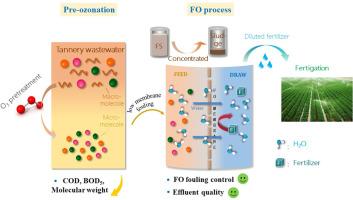Pre-ozonation coupled with forward osmosis with fertilizer as draw solution for simultaneous wastewater treatment and agricultural irrigation
IF 8.3
1区 工程技术
Q1 ENGINEERING, CHEMICAL
引用次数: 0
Abstract
Membrane-based processes have emerged as effective solutions for treating tannery wastewater. Persistent membrane fouling remains a significant obstacle to long-term operational sustainability, and residual pollutants often persist in the treated effluent. To address these challenges, we investigated an integrated ozone-forward osmosis (O3-FO) process, with a focus on evaluating the efficacy of pre-ozonation in alleviating membrane fouling, as well as exploring the possibilities of this integrated process for the reuse of tannery wastewater. Fertilizer, specifically 2 M Ca(NO3)2, served as the draw solution (DS) in this process. The findings reveal that the integrated system demonstrated remarkable pollutant retention capabilities. Notably, no metal was detected in the fertilizer. Therefore, the integrated process not only dilutes the fertilizer but also minimizes the risk of heavy metal contamination to both crops and soil. Furthermore, pre-ozonation effectively mitigated membrane fouling, resulting in an increase in membrane flux with a maximum increase of 20.98 % at 0.6 L/min. Orthogonal partial least squares-discriminant analysis (OPLS-DA) revealed pre-ozonation has the most significant impact on four parameters: water flux (), chemical oxygen demand (COD), fouling resistance () and oxidation reduction potential (ORP). Meanwhile, ammonium nitrogen (NH4-N) variation, dissolved organic carbon (DOC) variation and ORP played an important role in the four systems. Multi-criteria decision analysis (MCDA) showed that the 0.2 L/min O3-FO system achieved the highest score (0.66), followed by 0.6 L/min (0.53), 0.4 L/min (0.41) and 0 L/min (0.29). This research offers a theoretical framework for the synergistic integration of advanced oxidation and membrane technology in the treatment of industrial wastewater.

预臭氧与正渗透加肥料相结合,作为同时处理废水和农业灌溉的牵引解决方案
膜法工艺已成为处理制革废水的有效解决方案。持续的膜污垢仍然是长期可持续运行的一个重大障碍,而且残留污染物通常会在处理后的废水中持续存在。为了应对这些挑战,我们研究了一种臭氧-前向渗透(O3-FO)综合工艺,重点是评估预臭氧处理在减轻膜堵塞方面的功效,以及探索这种综合工艺在制革废水回用方面的可能性。肥料,特别是 2 M Ca(NO3)2,作为该工艺中的汲取溶液 (DS)。研究结果表明,该综合系统具有显著的污染物截留能力。值得注意的是,肥料中未检测到任何金属。因此,综合工艺不仅能稀释肥料,还能最大限度地降低重金属污染农作物和土壤的风险。此外,预臭氧处理有效地减轻了膜堵塞,从而提高了膜通量,在 0.6 升/分钟时,膜通量的最大增幅为 20.98%。正交偏最小二乘判别分析(OPLS-DA)显示,预臭氧处理对水流量(Jw)、化学需氧量(COD)、抗污能力(Rf)和氧化还原电位(ORP)这四个参数的影响最为显著。同时,铵态氮(NH4-N)变化、溶解有机碳(DOC)变化和氧化还原电位(ORP)在四个系统中也发挥了重要作用。多标准决策分析(MCDA)显示,0.2 升/分钟的 O3-FO 系统得分最高(0.66),其次是 0.6 升/分钟(0.53)、0.4 升/分钟(0.41)和 0 升/分钟(0.29)。这项研究为在处理工业废水时协同整合高级氧化和膜技术提供了一个理论框架。
本文章由计算机程序翻译,如有差异,请以英文原文为准。
求助全文
约1分钟内获得全文
求助全文
来源期刊

Desalination
工程技术-工程:化工
CiteScore
14.60
自引率
20.20%
发文量
619
审稿时长
41 days
期刊介绍:
Desalination is a scholarly journal that focuses on the field of desalination materials, processes, and associated technologies. It encompasses a wide range of disciplines and aims to publish exceptional papers in this area.
The journal invites submissions that explicitly revolve around water desalting and its applications to various sources such as seawater, groundwater, and wastewater. It particularly encourages research on diverse desalination methods including thermal, membrane, sorption, and hybrid processes.
By providing a platform for innovative studies, Desalination aims to advance the understanding and development of desalination technologies, promoting sustainable solutions for water scarcity challenges.
 求助内容:
求助内容: 应助结果提醒方式:
应助结果提醒方式:


